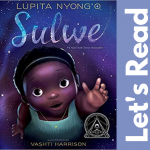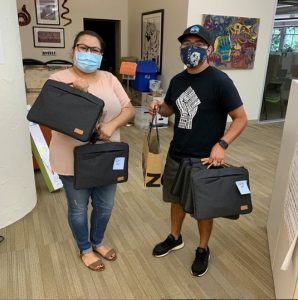Creative Spirit Helped Big Thought Re-Imagine Summer Programming in 2020
In pre-2020 era, summer programming at Big Thought was a machine. Planning for summer started in the fall, and teams used playbooks from prior years to put together the intricate layers of tasks and responsibilities to provide programming to more than 75,000 youth each summer. But Summer 2020 was a completely new experience in every way imaginable.
So we had to get creative
Creativity is what we do at Big Thought. So when it became clear that this summer was going to be unlike any other, our teams put their creativity to work on devising strategies on how to ensure that youth throughout Dallas had access to high quality learning programs all summer long.
First, we listened.
In early April, we surveyed youth and parents who had students enrolled in our programs to learn more about the challenges they were facing and what they needed most. Youth shared about the level of stress and uncertainty about their families and friends, and about the challenges to share tablets and laptops between multiple family members to keep up with school. Parents intimated similarly high levels of stress about the health and well-being of their family as well as concerns about how to help their children with at home learning.
When it was clear that our traditional summer programming options would likely not be possible, Big Thought partnered with several other large youth-serving nonprofits in May to seek feedback from families about what they needed and wanted most for summer programming. The Family Summer Needs Survey reached more than 1100 families from 115 zip codes in the greater Dallas area. Feedback from the Family Summer Needs Survey was shared with nonprofit partners in a large Virtual Town Hall and follow up dialogues emerged on how organizations could collaborate and build new capacities to meet family needs, concerns and expectations as we moved into summer.
Big Thought’s own program delivery took several different forms throughout the summer:
 Virtual Synchronous Programming – Many of our programs were offered live and in real time for youth. For elementary age learners, our social and emotional learning (SEL) specialists created a weekly book club where youth and families could sign up to do a read along with facilitated questions. For middle school girls, we offered Citi Tech Camp, a week-long camp where girls learned how to build a website from experts at Citi®. For high schoolers, we offered mentoring for young men in The Fellowship Initiative and small group art exploration with professional teaching artists in Artivism.
Virtual Synchronous Programming – Many of our programs were offered live and in real time for youth. For elementary age learners, our social and emotional learning (SEL) specialists created a weekly book club where youth and families could sign up to do a read along with facilitated questions. For middle school girls, we offered Citi Tech Camp, a week-long camp where girls learned how to build a website from experts at Citi®. For high schoolers, we offered mentoring for young men in The Fellowship Initiative and small group art exploration with professional teaching artists in Artivism.- Virtual Asynchronous Programming – Knowing that some families preferred “on demand” style experiences, Big Thought shifted our Dallas City of Learning platform to highlight more online experiences, which we called Digital Explorations. Big Thought re-envisioned many of our own most beloved in person curriculum into a self-guided, family-guided or pre-recorded video delivery models. We also engaged with dozens of local nonprofits and companies to incorporate their learning experiences into Digital Explorations, making it easier for youth and families to find and access online learning opportunities in a single, searchable location.
 Hybrid Models – We all know that youth love hands on learning. We developed a variety of different activity kits that combined self or family guided activities with either synchronous or asynchronous online experiences. These programs were offered for elementary age youth through Thriving Minds and SOARS, and for teens in our Creative Solutions
Hybrid Models – We all know that youth love hands on learning. We developed a variety of different activity kits that combined self or family guided activities with either synchronous or asynchronous online experiences. These programs were offered for elementary age youth through Thriving Minds and SOARS, and for teens in our Creative Solutions- In Person Programming – With so many of our families identifying as essential workers, Big Thought wanted to assist these families in filling the gap for child care needs. Early in the summer, Big Thought partnered with Dallas Independent School District and Child Care Group to operate a free learning center for children of essential health care workers for 3 of Dallas’ largest health organizations. Later in the summer, Big Thought partnered with the African American Museum to offer a three week in person camp for elementary age learners.
While Summer 2020 provided lots of innovative learning for youth, the Big Thought team also had to grow our ability to be resilient and responsive throughout the summer.
- Social and Emotional Learning must be embedded into everything we do. Youth have faced months of instability and limited opportunities to interact meaningfully with their friends and broader network of trusted adults. Youth also faced shock, confusion and pain from effects of racialized trauma as centuries of racism came to the forefront this summer. Finally, the impacts of COVID-19 and racialized trauma place even more barriers for youth in the most marginalized communities. Youth need opportunities to learn to understand their emotions, manage their stress and connect with others. Now more than ever, each program needed to create an opportunity for youth to build their social and emotional skills and well-being.
- Stress from the dual pandemic impacted our staff as much as it did our youth and communities. While we were concerned for the social and emotional needs of our youth, we had to be cognizant about the needs for our staff and their families as well. We created new spaces and opportunities for our team to interact, support one another and build community virtually. Juneteenth was established as an annual organizational holiday, and team members were offered a mental health day in June to help cope with their own stress.
- Technology is both an opportunity and a challenge. While some youth, families and staff transitioned easily to a remote programming environment, others had significant challenges. Dallas ranks last among major cities for “worst connection rate”, and the areas of the city with the least access to wifi are often the most marginalized areas of the city. Our virtual programming strategy had to incorporate opportunities for youth and families to be able to check out hot spots, tablets and other technology tools to be able to participate. Additionally, we needed to procure additional technology resources and training to ensure that our staff were able to stream their programming and respond to participants and peers in real time.Many of our older youth programs utilize a trauma-informed approach. Staff identified early on that building trust-based relationships with learners via Zoom is very different and much slower from how that trust can be built in face to face interactions. Our instructors transitioned much of their approach to small group work to help facilitate more authentic building of trust and engagement online.Finally, in the realm of online programming, many of our standard operating procedures and policies no longer fit. Our teams worked together quickly to create best practices to ensure student and instructor safety protocols, including passwords for video based meetings, clarifying approved tools for interacting with learners, and expectations for how to track and evaluate program effectiveness.
As “Back to School” becomes the top priority for youth and families, our learnings from this summer, partnerships with local school districts and program partners, and relationships with our families will be our strongest guides on how we can continue to help youth create, connect and discover throughout the year.
